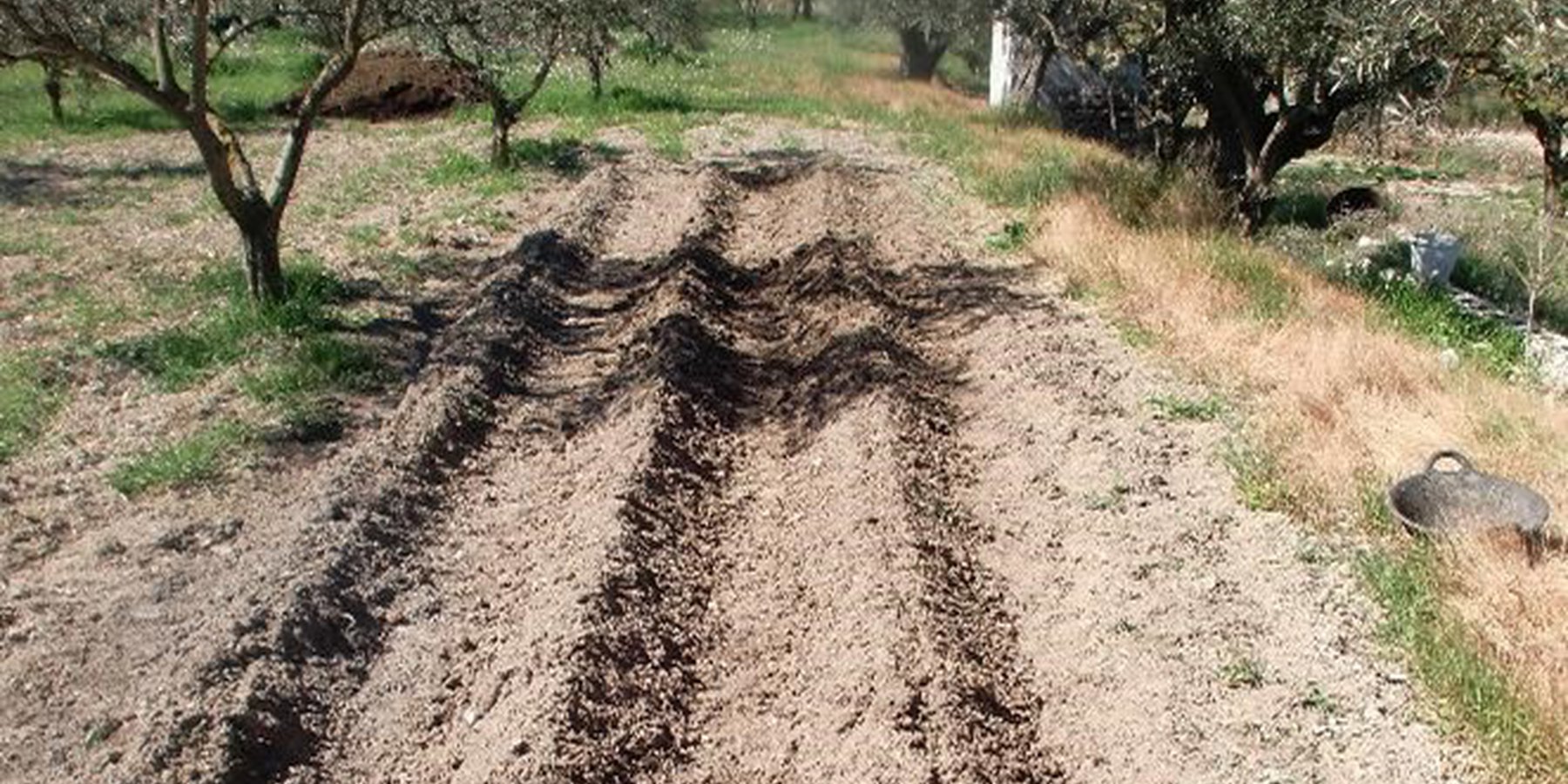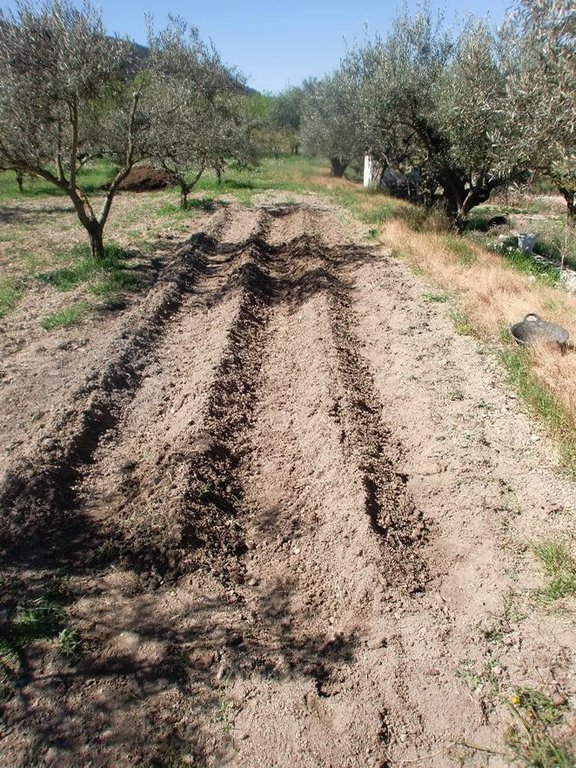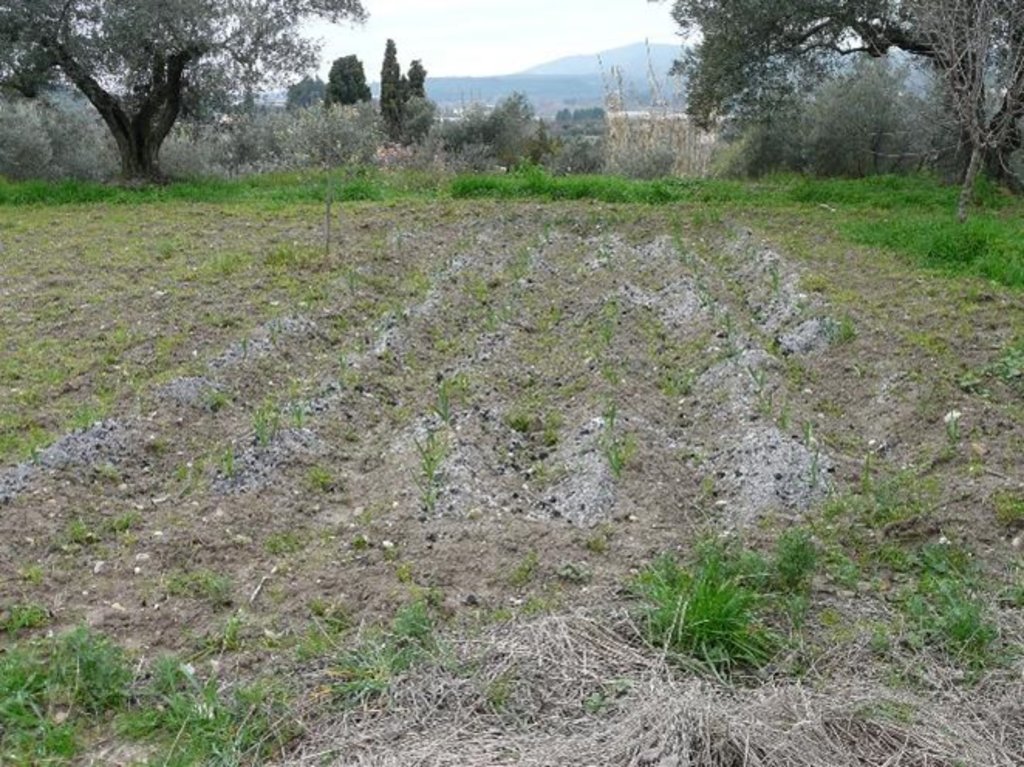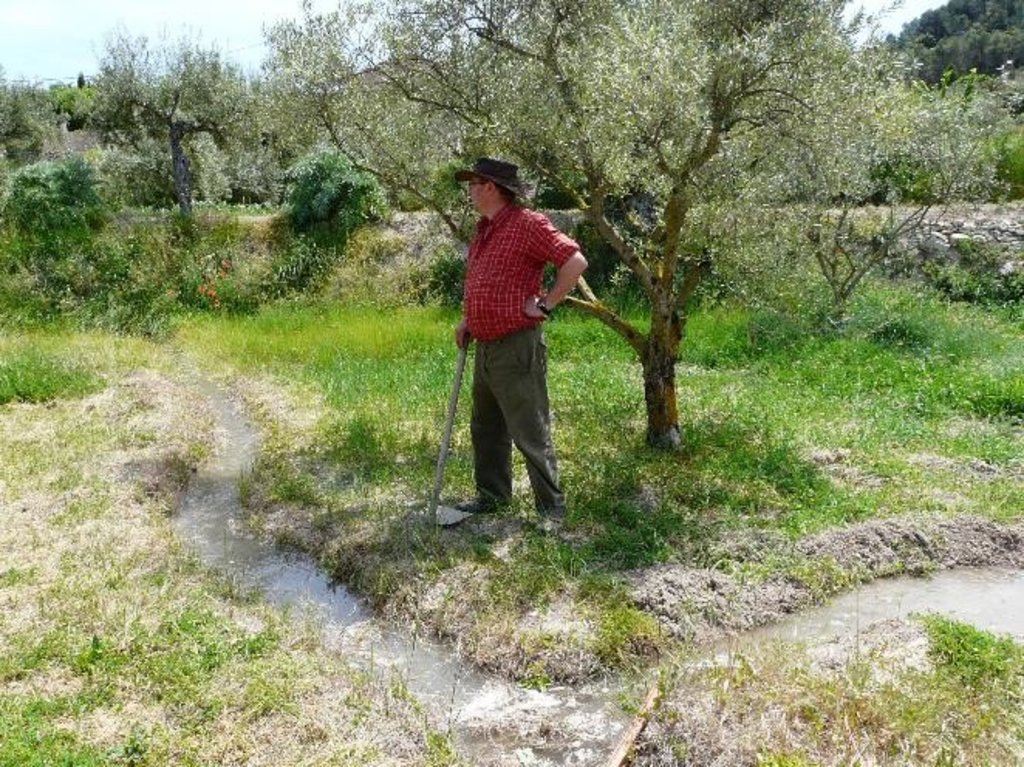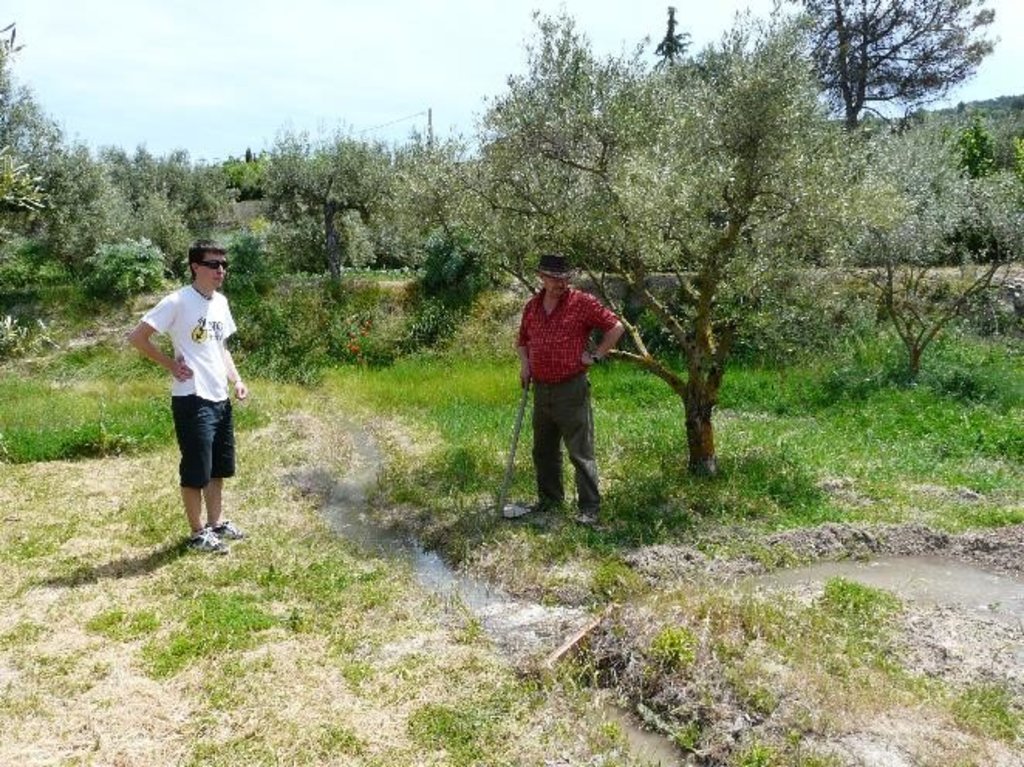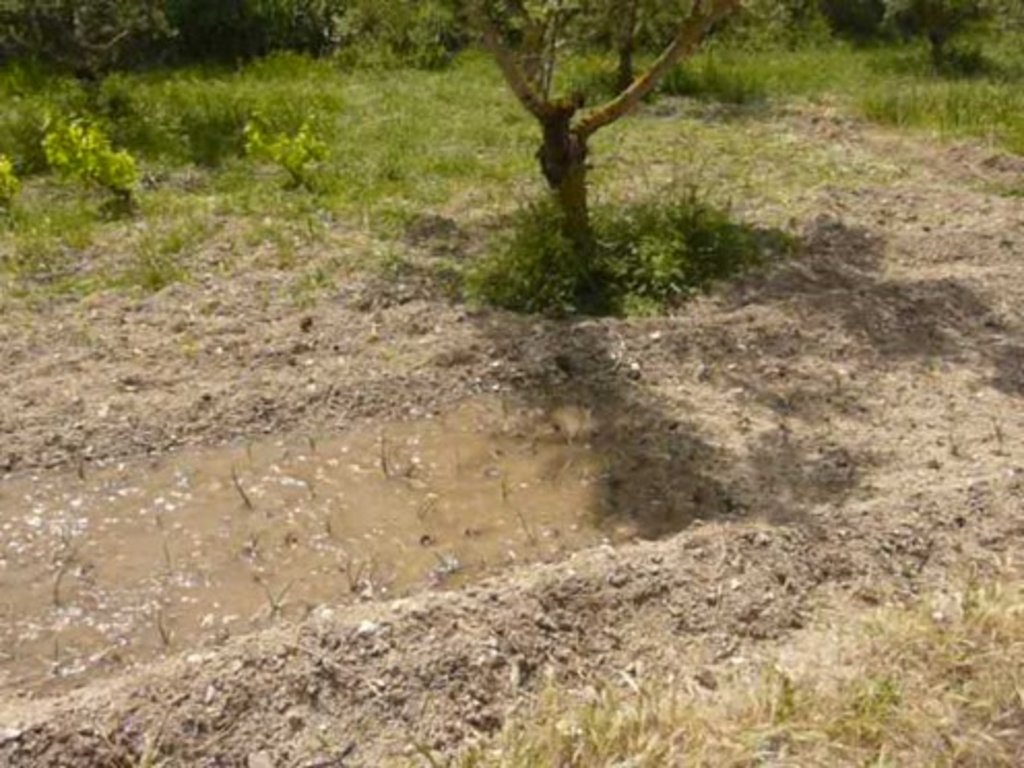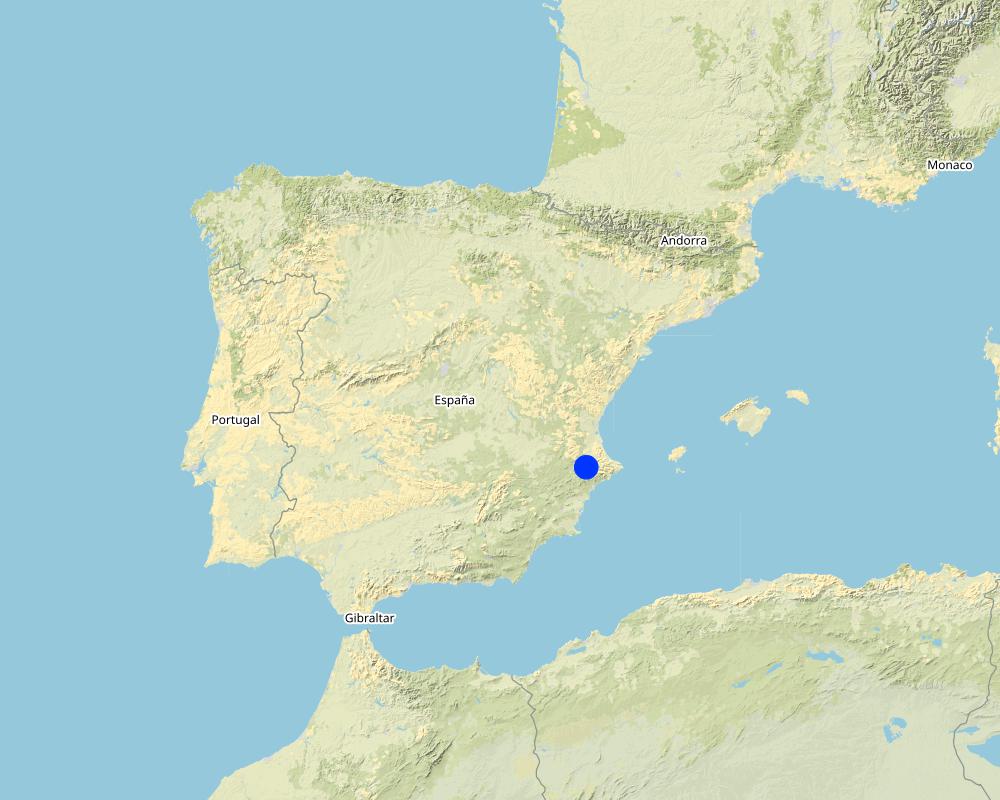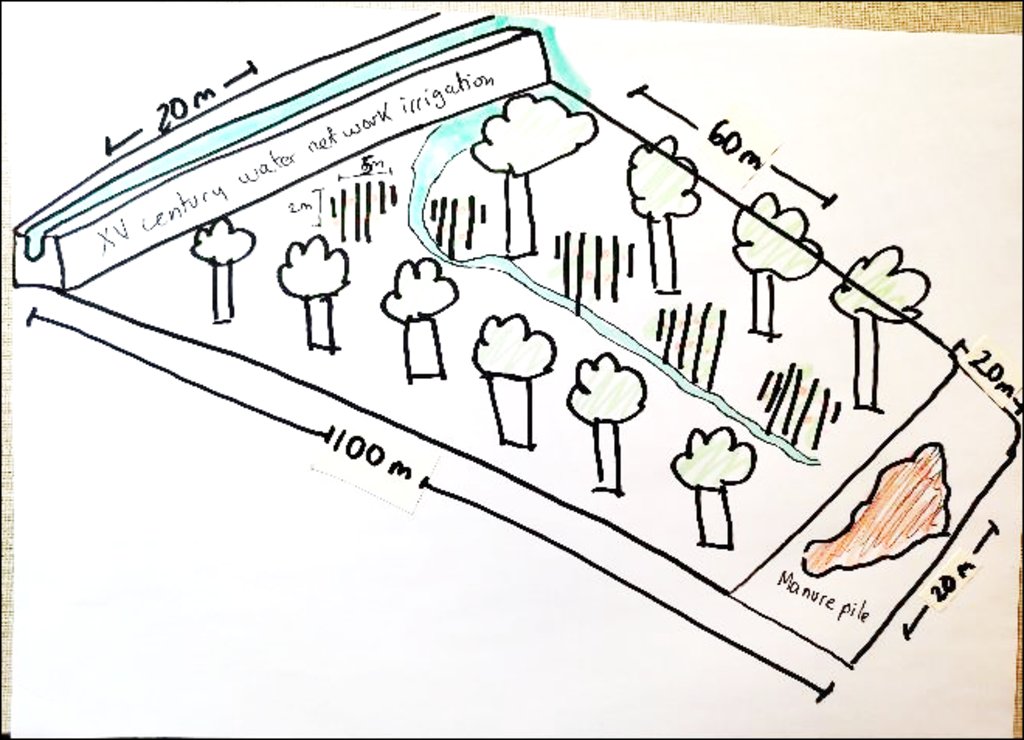Maintaining a 15th century irrigation system for a small orchard [Spain]
- Creation:
- Update:
- Compiler: Alicia Morugán-Coronado
- Editor: –
- Reviewers: William Critchley, Rima Mekdaschi Studer
Canalización de aguas de origen islámico en el riego de un huerto familiar
technologies_6435 - Spain
View sections
Expand all Collapse all1. General information
1.2 Contact details of resource persons and institutions involved in the assessment and documentation of the Technology
Key resource person(s)
land user:
Berenguer Bodí Mercedes
Spain
1.3 Conditions regarding the use of data documented through WOCAT
The compiler and key resource person(s) accept the conditions regarding the use of data documented through WOCAT:
Yes
1.4 Declaration on sustainability of the described Technology
Is the Technology described here problematic with regard to land degradation, so that it cannot be declared a sustainable land management technology?
No
2. Description of the SLM Technology
2.1 Short description of the Technology
Definition of the Technology:
A 15th century irrigation system is used on a small, intercropped and manured family orchard located in Valencia, in la Vall d’Albaida county (Spain)
2.2 Detailed description of the Technology
Description:
This technology is applied in a family orchard located in a small town (Bocairent) in Valencia, close to the Serra Mariola Natural Park. In the county of Vall d’Albaida, a 15th century system irrigates all the agricultural lands in the area. In this case study, the historical system has been used, since 1998, to irrigate a small plot of 0.2 ha. Water is diverted from the main water canal to a secondary channel which leads to the plot. Irrigation is applied when it is necessary, based on crop water requirements and the rainfall recorded. The original source of the water is the Serra Mariola range from where it flows into the Clarià river. Within the plot there are fruit trees as well as 5 subplots of 10 square meters (5 x 2m each). The subplots are used for vegetables (tomatoes, potatoes, fava beans, etc) under a rotational system (2 cycles per year). These 5 subplots are located between the rows of fruit trees (olives, almonds, figs, cherries, peaches), in an intercropping system. The whole field is fertilized annually with organic manure, which is stored at one end of the plot. This horse or sheep manure is acquired from a farm near the orchard. Pest control avoids artificial pesticides and fungicides: pests are controlled through encouraging natural predators. Weeds are removed by hand several times per season. The main purpose of this technology is the improvement of soil structure and organic matter content of the soil, while also preventing soil erosion caused by surface runoff. Avoiding pesticides and following an intercropping system gives multiple benefits: these include (a) maintaining biodiversity, (b) enhancing natural pollinators and pest predators, (c) respecting the Serra Mariola natural park, (d) improving ecosystem supporting services (nutrient cycling, soil formation, habitat provision, flood regulation) and regulating services (biological control pest and disease control), (d) creating pollination areas, and (e) encouraging carbon sequestration through permanent green cover in the intercropping system. Another benefit is the maintenance of cultural heritage: namely the 15th century, historically complex, irrigation system, which has been in use since being designed by Arabs up to the present day. Land users are continuously improving the technology by minimizing the impact on the agro-ecosystem through avoiding the use of pesticides. They are proud also with the improvement of the nutrient status of the soil, and the level of soil organic matter, achieved through the application of organic manure, as well as the intercropping and rotational system.
2.3 Photos of the Technology
2.5 Country/ region/ locations where the Technology has been applied and which are covered by this assessment
Country:
Spain
Region/ State/ Province:
Valencia
Further specification of location:
Bocairent
Specify the spread of the Technology:
- applied at specific points/ concentrated on a small area
Is/are the technology site(s) located in a permanently protected area?
No
Map
×2.6 Date of implementation
Indicate year of implementation:
1998
2.7 Introduction of the Technology
Specify how the Technology was introduced:
- through land users' innovation
- as part of a traditional system (> 50 years)
3. Classification of the SLM Technology
3.1 Main purpose(s) of the Technology
- improve production
- reduce, prevent, restore land degradation
- conserve ecosystem
- protect a watershed/ downstream areas – in combination with other Technologies
- preserve/ improve biodiversity
3.2 Current land use type(s) where the Technology is applied
Land use mixed within the same land unit:
No

Cropland
- Annual cropping
- Perennial (non-woody) cropping
- Tree and shrub cropping
Number of growing seasons per year:
- 2
Specify:
Summer/Winter
Is intercropping practiced?
Yes

Waterways, waterbodies, wetlands
- Drainage lines, waterways
3.3 Has land use changed due to the implementation of the Technology?
Has land use changed due to the implementation of the Technology?
- No (Continue with question 3.4)
3.4 Water supply
Water supply for the land on which the Technology is applied:
- mixed rainfed-irrigated
3.5 SLM group to which the Technology belongs
- rotational systems (crop rotation, fallows, shifting cultivation)
- integrated pest and disease management (incl. organic agriculture)
- irrigation management (incl. water supply, drainage)
3.6 SLM measures comprising the Technology

agronomic measures
- A1: Vegetation/ soil cover
- A2: Organic matter/ soil fertility
- A6: Residue management

structural measures
- S3: Graded ditches, channels, waterways
- S7: Water harvesting/ supply/ irrigation equipment
3.7 Main types of land degradation addressed by the Technology

soil erosion by water
- Wt: loss of topsoil/ surface erosion

chemical soil deterioration
- Cn: fertility decline and reduced organic matter content (not caused by erosion)

water degradation
- Hp: decline of surface water quality
3.8 Prevention, reduction, or restoration of land degradation
Specify the goal of the Technology with regard to land degradation:
- prevent land degradation
- reduce land degradation
4. Technical specifications, implementation activities, inputs, and costs
4.1 Technical drawing of the Technology
Technical specifications (related to technical drawing):
5 subplots of 10 square meters (5x2m) are used forvegetables crops (tomatoes, potatoes, fava beans, etc) in a crop rotation system (2 cycles per year). The subplots are between fruit trees line (olive tree, almond tree, fig tree, cherry tree, peaches trees), in an intercropping system. Irrigation is made with a temporal secondary channel from the mean water canal (51th century water network). All the agricultural field (0.2 ha) is fertilized annually with organic manure stored at the end of the plot.
Author:
Alicia Morugan-Coronado
Date:
09/04/2022
4.2 General information regarding the calculation of inputs and costs
Specify how costs and inputs were calculated:
- per Technology area
Indicate size and area unit:
0.2 ha
other/ national currency (specify):
euro
If relevant, indicate exchange rate from USD to local currency (e.g. 1 USD = 79.9 Brazilian Real): 1 USD =:
0.99
4.3 Establishment activities
| Activity | Timing (season) | |
|---|---|---|
| 1. | Soil preparation | One per season |
| 2. | Soil ploughing | Twice per year (2 cycles rotation) |
| 3. | Manuring | Once per year |
| 4. | Water irrigation | Periodically |
| 5. | Tree plantation | Once per year |
| 6. | Vegetables plantation | Twice per year (2 cycles rotation) |
4.4 Costs and inputs needed for establishment
| Specify input | Unit | Quantity | Costs per Unit | Total costs per input | % of costs borne by land users | |
|---|---|---|---|---|---|---|
| Labour | Manuring | person-day | 1.0 | 100.0 | ||
| Labour | Soil ploughing or soil preparation | person-day | 4.0 | 10.0 | 40.0 | 100.0 |
| Labour | Water irrigation | litres | 100.0 | 100.0 | ||
| Labour | Plants plantation | person-day | 2.0 | 25.0 | 50.0 | 100.0 |
| Equipment | Hoe | piece | 1.0 | 10.0 | 10.0 | 100.0 |
| Equipment | shovel | piece | 1.0 | 18.0 | 18.0 | 100.0 |
| Plant material | Seed | gr | 200.0 | 1.0 | 200.0 | 100.0 |
| Plant material | Tree | piece | 25.0 | 15.0 | 375.0 | 100.0 |
| Plant material | Vegetables | piece | 25.0 | 4.0 | 100.0 | 100.0 |
| Fertilizers and biocides | Horse or sheep manure | kg | 80.0 | 100.0 | ||
| Total costs for establishment of the Technology | 793.0 | |||||
| Total costs for establishment of the Technology in USD | 801.01 | |||||
4.5 Maintenance/ recurrent activities
| Activity | Timing/ frequency | |
|---|---|---|
| 1. | Weeding | 4 times per year |
| 2. | Harvesting | 2 times per year |
| 3. | Manuring | 1 time per year |
| 4. | Vegetables or seed plantation | 2 times per year o vegetable cycle |
| 5. | Tree re-plantation | Eventually if tree loss |
| 6. | Soil ploughing | 2 times per year or vegetables cycle |
| 7. | Water irrigation | Periodically |
4.6 Costs and inputs needed for maintenance/ recurrent activities (per year)
| Specify input | Unit | Quantity | Costs per Unit | Total costs per input | % of costs borne by land users | |
|---|---|---|---|---|---|---|
| Labour | Weeding | person-day | 1.0 | 100.0 | ||
| Labour | Harvesting | person-day | 1.0 | 100.0 | ||
| Labour | Soil ploughing | person-day | 1.0 | 100.0 | ||
| Labour | Water irrigation | Litres | 100.0 | 100.0 | ||
| Equipment | Hoe | piece | 1.0 | 10.0 | 10.0 | 100.0 |
| Equipment | Scissors | piece | 1.0 | 10.0 | 10.0 | 100.0 |
| Equipment | Shovel | piece | 1.0 | 15.0 | 15.0 | 100.0 |
| Plant material | Seed | gr | 200.0 | 1.0 | 200.0 | 100.0 |
| Plant material | Vegetables plant | pieces | 20.0 | 4.0 | 80.0 | 100.0 |
| Plant material | Fruit trees plant | pieces | 5.0 | 18.0 | 90.0 | 100.0 |
| Fertilizers and biocides | Manuring | Kg | 80.0 | 100.0 | ||
| Other | Weeding | person-day | 1.0 | 100.0 | ||
| Total costs for maintenance of the Technology | 405.0 | |||||
| Total costs for maintenance of the Technology in USD | 409.09 | |||||
4.7 Most important factors affecting the costs
Describe the most determinate factors affecting the costs:
The users has already the material and the plants, only the manure is a gift from a neighbour
5. Natural and human environment
5.1 Climate
Annual rainfall
- < 250 mm
- 251-500 mm
- 501-750 mm
- 751-1,000 mm
- 1,001-1,500 mm
- 1,501-2,000 mm
- 2,001-3,000 mm
- 3,001-4,000 mm
- > 4,000 mm
Specify average annual rainfall (if known), in mm:
520.00
Specifications/ comments on rainfall:
Bocairent has dry periods in January, February, March, June, July, August and December.
On average, September is the wettest month with 2 inch (50 mm) of precipitation.
On average, July is the driest month with 0.2 inch (4 mm) of precipitation.
Agro-climatic zone
- semi-arid
In Bocairent, the average annual temperature is 15.5 °C | 60.0 °F.
5.2 Topography
Slopes on average:
- flat (0-2%)
- gentle (3-5%)
- moderate (6-10%)
- rolling (11-15%)
- hilly (16-30%)
- steep (31-60%)
- very steep (>60%)
Landforms:
- plateau/plains
- ridges
- mountain slopes
- hill slopes
- footslopes
- valley floors
Altitudinal zone:
- 0-100 m a.s.l.
- 101-500 m a.s.l.
- 501-1,000 m a.s.l.
- 1,001-1,500 m a.s.l.
- 1,501-2,000 m a.s.l.
- 2,001-2,500 m a.s.l.
- 2,501-3,000 m a.s.l.
- 3,001-4,000 m a.s.l.
- > 4,000 m a.s.l.
Indicate if the Technology is specifically applied in:
- not relevant
Comments and further specifications on topography:
Is a flat terrain, approximately 1% slope.
5.3 Soils
Soil depth on average:
- very shallow (0-20 cm)
- shallow (21-50 cm)
- moderately deep (51-80 cm)
- deep (81-120 cm)
- very deep (> 120 cm)
Soil texture (topsoil):
- medium (loamy, silty)
Soil texture (> 20 cm below surface):
- fine/ heavy (clay)
Topsoil organic matter:
- low (<1%)
5.4 Water availability and quality
Ground water table:
< 5 m
Availability of surface water:
good
Water quality (untreated):
good drinking water
Water quality refers to:
surface water
Is water salinity a problem?
No
Is flooding of the area occurring?
Yes
Regularity:
episodically
5.5 Biodiversity
Species diversity:
- high
Habitat diversity:
- high
5.6 Characteristics of land users applying the Technology
Sedentary or nomadic:
- Sedentary
Market orientation of production system:
- subsistence (self-supply)
Off-farm income:
- > 50% of all income
Relative level of wealth:
- average
Individuals or groups:
- individual/ household
Level of mechanization:
- manual work
Gender:
- women
Age of land users:
- middle-aged
Indicate other relevant characteristics of the land users:
It is a family with 6 members of different ages, the oldest is 60 years-old and the youngest 24 years old
5.7 Average area of land used by land users applying the Technology
- < 0.5 ha
- 0.5-1 ha
- 1-2 ha
- 2-5 ha
- 5-15 ha
- 15-50 ha
- 50-100 ha
- 100-500 ha
- 500-1,000 ha
- 1,000-10,000 ha
- > 10,000 ha
Is this considered small-, medium- or large-scale (referring to local context)?
- small-scale
Comments:
0.2 ha
5.8 Land ownership, land use rights, and water use rights
Land ownership:
- individual, titled
Land use rights:
- individual
Water use rights:
- individual
Are land use rights based on a traditional legal system?
Yes
5.9 Access to services and infrastructure
health:
- poor
- moderate
- good
education:
- poor
- moderate
- good
technical assistance:
- poor
- moderate
- good
employment (e.g. off-farm):
- poor
- moderate
- good
markets:
- poor
- moderate
- good
energy:
- poor
- moderate
- good
roads and transport:
- poor
- moderate
- good
drinking water and sanitation:
- poor
- moderate
- good
financial services:
- poor
- moderate
- good
6. Impacts and concluding statements
6.1 On-site impacts the Technology has shown
Socio-economic impacts
Production
crop production
Comments/ specify:
The user observes an increase in yield year per year, even in the fruit trees
crop quality
Comments/ specify:
The user says that the quality of the vegetables increases annually (visual observation)
Water availability and quality
drinking water availability
Comments/ specify:
The user explain that avoiding the use of pesticides and inorganic fertilization, the quality of water is better than before
Income and costs
expenses on agricultural inputs
Comments/ specify:
Because the manure is a gift, no costs are involve in fertilization labour. Avoiding pesticides is another reason to decrease the agricultural inputs
Socio-cultural impacts
food security/ self-sufficiency
Comments/ specify:
The user and its family self-consumed the vegetables that they harvest in the orchard
health situation
Comments/ specify:
Avoiding pesticides and chemical fertilization the health risks decreased on the user and its family
recreational opportunities
Comments/ specify:
The legacy of the orchard to the next family members is assured because is a tradition to spend weekends working on the orchard and later eat Paella (a traditional Spanish dish)
SLM/ land degradation knowledge
Comments/ specify:
The user learns about soil quality and degratation with the experience and observation
Ecological impacts
Water cycle/ runoff
surface runoff
Comments/ specify:
the permanent green cover as an intercropping system maintains the soil and decreases surface runoff
Soil
soil moisture
Comments/ specify:
the permanent green cover as an intercropping system maintains the soil moisture
soil cover
Comments/ specify:
the permanent green cover as an intercropping system maintains the soil
soil loss
Comments/ specify:
the permanent green cover as an intercropping system avoids soil loss
soil accumulation
Comments/ specify:
the permanent green cover as an intercropping system enhances soil formation
soil crusting/ sealing
Comments/ specify:
the permanent green cover as an intercropping system decreases soil sealing
soil compaction
Comments/ specify:
the permanent green cover and the manure application decreases soil compactation
nutrient cycling/ recharge
Comments/ specify:
the permanent green cover and the manure application increases nutrient cycling
soil organic matter/ below ground C
Comments/ specify:
the permanent green cover and the manure application increases organic matter anually
Biodiversity: vegetation, animals
Vegetation cover
Comments/ specify:
The intercropping system maintain vegetation cover during the year between fruit trees rows
biomass/ above ground C
Comments/ specify:
The intercropping system maintain biomassC during the year between fruit trees rows
plant diversity
Comments/ specify:
The intercropping system increases plant diversity during the year between fruit trees rows
invasive alien species
Comments/ specify:
The intercropping system attracts pollinators and pest predators naturally
animal diversity
Comments/ specify:
The intercropping system enhances the presence of birds or little mammals
pest/ disease control
Comments/ specify:
The intercropping system enhances the pest control with the presence of natural killers pest
6.2 Off-site impacts the Technology has shown
reliable and stable stream flows in dry season
buffering/ filtering capacity
6.3 Exposure and sensitivity of the Technology to gradual climate change and climate-related extremes/ disasters (as perceived by land users)
Gradual climate change
Gradual climate change
| Season | increase or decrease | How does the Technology cope with it? | |
|---|---|---|---|
| annual temperature | increase | moderately | |
| seasonal temperature | autumn | increase | moderately |
| annual rainfall | increase | well | |
| seasonal rainfall | autumn | increase | well |
Climate-related extremes (disasters)
Meteorological disasters
| How does the Technology cope with it? | |
|---|---|
| local hailstorm | well |
| local sandstorm/ duststorm | well |
Climatological disasters
| How does the Technology cope with it? | |
|---|---|
| heatwave | well |
| cold wave | very well |
| drought | well |
| forest fire | very well |
Hydrological disasters
| How does the Technology cope with it? | |
|---|---|
| flash flood | well |
Biological disasters
| How does the Technology cope with it? | |
|---|---|
| insect/ worm infestation | well |
6.4 Cost-benefit analysis
How do the benefits compare with the establishment costs (from land users’ perspective)?
Short-term returns:
slightly positive
Long-term returns:
very positive
How do the benefits compare with the maintenance/ recurrent costs (from land users' perspective)?
Short-term returns:
neutral/ balanced
Long-term returns:
neutral/ balanced
6.5 Adoption of the Technology
- single cases/ experimental
Of all those who have adopted the Technology, how many did so spontaneously, i.e. without receiving any material incentives/ payments?
- 0-10%
6.6 Adaptation
Has the Technology been modified recently to adapt to changing conditions?
No
6.7 Strengths/ advantages/ opportunities of the Technology
| Strengths/ advantages/ opportunities in the land user’s view |
|---|
| Free pesticides orchard, with organic manure from local farm and maintaining irrigation water supply following millenary water rules |
| Eating healthily |
| Saving money in vegetables and fruit orchards |
| Eating your own grow food |
| Strengths/ advantages/ opportunities in the compiler’s or other key resource person’s view |
|---|
| Improvement in soil structure and minimizing soil compactation |
| Improvement in organic matter content |
| Controlling water erosion on surface |
| Maintaining biodiversity of natural reserve avoiding the use of pesticides |
6.8 Weaknesses/ disadvantages/ risks of the Technology and ways of overcoming them
| Weaknesses/ disadvantages/ risks in the land user’s view | How can they be overcome? |
|---|---|
| Manual hours for land preparation | Family help on weekends |
| Pest control manual | Try new methods or assessing the correct moment to do the control |
| Controlling spontaneus plants manually | Diversify orchard to minimize the presence of spontaneous plants |
| Weaknesses/ disadvantages/ risks in the compiler’s or other key resource person’s view | How can they be overcome? |
|---|---|
| Initial preparation of terrain | Overcome by saving cost in annual crop yield |
| Improving knowledgement in crop diversification | Receiving technical advice from experts |
| Problems in pest control | Improving the presence of beneficial insects or predators |
7. References and links
7.1 Methods/ sources of information
- field visits, field surveys
1 field visit
- interviews with land users
10 land user interviews
- compilation from reports and other existing documentation
When were the data compiled (in the field)?
09/04/2022
Comments:
One in situ interview (09 April 2022) and the rest of info was compiled by phone with the land user
7.2 References to available publications
Title, author, year, ISBN:
Historical irrigation system at l'Horta de València
Available from where? Costs?
https://www.fao.org/giahs/news/newsletter-detail/es/c/1253069
Title, author, year, ISBN:
Los regadíos tradicionales del Vinalopó (Alto y Medio). Jorge Hermosilla, ed. Colección: Regadíos Históricos Valencianos. ISBN: 978-84-370-6777-3
Available from where? Costs?
https://puv.uv.es/los-regadios-tradicionales-del-vinalopo-alto-y-medio.html?___store=espanyol&___from_store=valencia
Title, author, year, ISBN:
Los regadíos tradicionales del Vinalopó (Alto y Medio) AUTOR/A: HERMOSILLA PLA, JORGE
Available from where? Costs?
https://www.todostuslibros.com/libros/los-regadios-tradicionales-del-vinalopo-alto-y-medio_978-84-482-4686-0
Title, author, year, ISBN:
Los regadíos históricos españoles paisajes cuturales, paisajes sostenibles AUTOR/A: HERMOSILLA PLA, JORGE / PEÑA ORTIZ, MARTÍN / ANTEQUERA FERNÁNDEZ, MIGUEL 978-84-491-1000-9
Available from where? Costs?
https://www.todostuslibros.com/libros/los-regadios-historicos-espanoles_978-84-491-1000-9
Title, author, year, ISBN:
Evaluación patrimonial de azudes en la demarcación hidrográfica del Júcar AUTOR/A: HERMOSILLA PLA, JORGE 978-84-17508-17-3 / Tirant Humanidades
Available from where? Costs?
https://www.todostuslibros.com/libros/evaluacion-patrimonial-de-azudes-en-la-demarcacion-hidrografica-del-jucar_978-84-17508-17-3
Title, author, year, ISBN:
Cuadernos de historia de España versión impresa ISSN 0325-1195versión On-line ISSN 1850-2717 Cuad. hist. Esp. v.80 Buenos Aires ene./dic. 2006
Available from where? Costs?
http://www.scielo.org.ar/scielo.php?script=sci_arttext&pid=S0325-11952006000100002
7.3 Links to relevant online information
Title/ description:
Heritage-catalogue valencian
URL:
https://www.uv.es/horta-valencia-chair/en/heritage-catalogue/presentacio-del-cataleg/presentacio.html
Title/ description:
ESTEPA RESEARCH GROUP
URL:
https://www.uv.es/uvweb/departamento-geografia/es/investigacion/grupos-investigacion/estepa-estudios-del-territorio-del-patrimonio-/actividades-del-grupo/lineas-investigacion-1285858445772.html
Title/ description:
Bocairent guided visits
URL:
https://www.visitabocairent.com/bocairent-y-el-agua/
Links and modules
Expand all Collapse allLinks
No links
Modules
No modules


